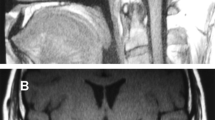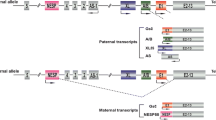Abstract
The Pit-1 gene encodes the POU-domain transcription factor Pit-1 which is important for the differentiation of the anterior pituitary and regulation of the PRL, GH and TSH genes. As a member of the POU domain transcription factors, Pit-1 contains a DNA-binding region, consisting of a POU-specific domain and a POU homeodomain. Mutation of the Pit-1 gene causes hypoplasia of the pituitary gland and deficiencies of GH, PRL and TSH. In a DNA sample from a 3-month-old girl with severe growth deficiency from birth, single stranded conformational polymorphism analysis of the Pit-1 gene identified a gel shift in exon 6. DNA-sequencing disclosed a single base mutation in codon 271 (CGG to TGG) that changes arginine to tryptophan (R271W) in the POU homeodomain. The patient presented distinct facial features with prominent forehead, marked mid-facial hypoplasia with depressed nasal bridge, deep-set eyes and a short nose with anteverted nostrils. MRI examination showed a hypoplastic pituitary gland. Low serum GH did not respond to insulin-arginine provocation or GHRH tests. PRL levels below the detection limit did not increase in response to a TRH test. T4 and free T4 was below detection limit (<20 nmol/l and <4 pmol/l). TSH was 2.0 mU/l and showed a blunt response to 6.0 mU/l following TRH test. TBG was normal. In spite of inappropriately low TSH and very low T4, T3 was in the low normal range (1.4–1.6 nmol/l) and she was clinically euthyroid. The thyroid function tests are consistent with increased monodeiodination activity and increased conversion of T4 to T3, possibly related to the Pit-1 gene mutation. GH and T4 treatment resulted in catch-up growth continued during 5 years of therapy.
Conclusion Reports of nine other cases of R271W mutations of different populations as well as the present Norwegian patient suggest codon 271 of exon 6 to be a “hot spot” for Pit-1 mutations. To enable rapid and simple detection of this type of de novo mutation we have designed a specific amplification-created-restriction-site assay to check for the R271W mutation in patients suspected to have this rare form of genetic defect in growth hormone production.
Similar content being viewed by others
Author information
Authors and Affiliations
Rights and permissions
About this article
Cite this article
Aarskog, D., Eiken, H.G., Bjerknes, R. et al. Pituitary dwarfism in the R271W Pit-1 gene mutation. Eur J Pediatr 156, 829–834 (1997). https://doi.org/10.1007/s004310050722
Received:
Accepted:
Published:
Issue Date:
DOI: https://doi.org/10.1007/s004310050722




